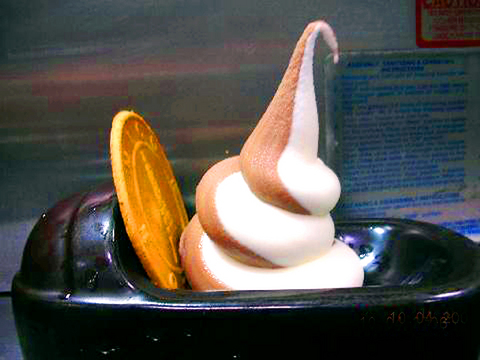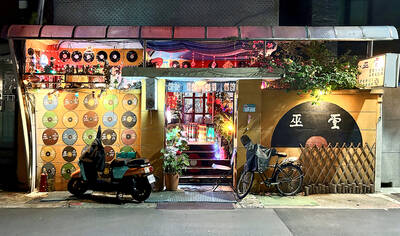A Kaohsiung restaurant famous for its garish bathroom decor has opened a branch in Shilin.
Marton -- the name sounds like "toilet" in Mandarin -- serves up pasta, rice curries and ice cream in miniature loos, bathtubs and Japanese-style squat toilets. Customers sit on real commodes decorated with fanciful ocean themes and are encouraged to stir up their meals so they look like, well ...
"It's delicious," giggled Violet, 15, as she and three classmates dug into a pile of brown mush they swore was ice cream. "It's special and funny," friend Ivy added.

PHOTO COURTESY OF MARTON
If a recent visit was any indication, the gimmick works. A score of happy teenagers and office workers slurped hot pot from purple toilets and picked at appetizers in plastic turd-shaped swirls. The tables -- real porcelain sinks with glass covers -- each contained piles of notes penned by satisfied customers, many of the scatological variety. "Our turds are really thick," read one.
Marton is all about the atmosphere. Set meals consisting of soup, a main course and ice cream offer plenty of potential for play. Served in a light blue bathtub, a main course of seafood casserole nearly floated in its soggy, gray stew. All the better to stir up, but not very filling. Clever presentation aside, little distinguished this dish from similar fare that can be obtained at cheaper prices from Taipei's legion of coffee shops. The melted cheese tasted artificial and the portion was on the small side. There were, however, two mussels buried along with their shells in the muck.
The ice cream, a small vanilla and chocolate swirl resembling a cartoon turd, came in a tiny squat toilet and tasted like the convenience store variety. This was disappointing, since Marton's founder tested the bathroom concept with a roadside ice cream stand before opening his first full-blown restaurant in Kaohsiung. Perhaps these were bad choices. Branch manager Jessica Huang recommended the current favorite, creamy hot pot (日式濃牛奶鍋). The Marton No. 2 ice cream (馬桶2號) also looked intriguing. It features a scoop of strawberry ice cream, a chocolate-vanilla ice cream swirl and passion fruit sauce.
Those planning on becoming repeat customers should pick up a card and get it stamped after each meal. Five stamps earn a free ice cream sundae. Thirty are good for a commode like the one customers sit on. These can also be purchased directly, as can whimsical turds and other sculptures. Customers can also order the toilet seats, which are decorated with seashells and starfish.

The Lee (李) family migrated to Taiwan in trickles many decades ago. Born in Myanmar, they are ethnically Chinese and their first language is Yunnanese, from China’s Yunnan Province. Today, they run a cozy little restaurant in Taipei’s student stomping ground, near National Taiwan University (NTU), serving up a daily pre-selected menu that pays homage to their blended Yunnan-Burmese heritage, where lemongrass and curry leaves sit beside century egg and pickled woodear mushrooms. Wu Yun (巫雲) is more akin to a family home that has set up tables and chairs and welcomed strangers to cozy up and share a meal

Dec. 8 to Dec. 14 Chang-Lee Te-ho (張李德和) had her father’s words etched into stone as her personal motto: “Even as a woman, you should master at least one art.” She went on to excel in seven — classical poetry, lyrical poetry, calligraphy, painting, music, chess and embroidery — and was also a respected educator, charity organizer and provincial assemblywoman. Among her many monikers was “Poetry Mother” (詩媽). While her father Lee Chao-yuan’s (李昭元) phrasing reflected the social norms of the 1890s, it was relatively progressive for the time. He personally taught Chang-Lee the Chinese classics until she entered public

Last week writer Wei Lingling (魏玲靈) unloaded a remarkably conventional pro-China column in the Wall Street Journal (“From Bush’s Rebuke to Trump’s Whisper: Navigating a Geopolitical Flashpoint,” Dec 2, 2025). Wei alleged that in a phone call, US President Donald Trump advised Japanese Prime Minister Sanae Takaichi not to provoke the People’s Republic of China (PRC) over Taiwan. Wei’s claim was categorically denied by Japanese government sources. Trump’s call to Takaichi, Wei said, was just like the moment in 2003 when former US president George Bush stood next to former Chinese premier Wen Jia-bao (溫家寶) and criticized former president Chen

President William Lai (賴清德) has proposed a NT$1.25 trillion (US$40 billion) special eight-year budget that intends to bolster Taiwan’s national defense, with a “T-Dome” plan to create “an unassailable Taiwan, safeguarded by innovation and technology” as its centerpiece. This is an interesting test for the Chinese Nationalist Party (KMT), and how they handle it will likely provide some answers as to where the party currently stands. Naturally, the Lai administration and his Democratic Progressive Party (DPP) are for it, as are the Americans. The Chinese Communist Party (CCP) is not. The interests and agendas of those three are clear, but